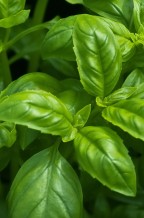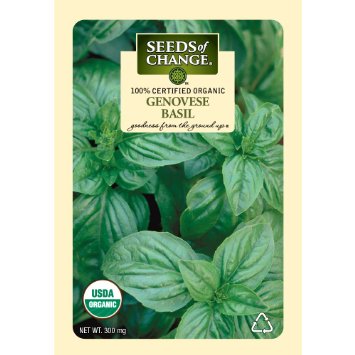 Sweet basil (Ocimum basilicum) is an annual native to India but is more closely associated with Italian food. Most basils available in the US belong to the species basciliucum with lemon basil and holy basil being the notable exceptions. Favorite cultivars and varieties of sweet basil include ‘Anise’, ‘Cinnamon’ ‘Purpurascens’, ‘Crispum’,‘Green Ruffles’, ‘Spicy Globe’, ‘Purple Ruffles’ , Genovese and Thai basil (but not Thai lemon.)
Sweet basil (Ocimum basilicum) is an annual native to India but is more closely associated with Italian food. Most basils available in the US belong to the species basciliucum with lemon basil and holy basil being the notable exceptions. Favorite cultivars and varieties of sweet basil include ‘Anise’, ‘Cinnamon’ ‘Purpurascens’, ‘Crispum’,‘Green Ruffles’, ‘Spicy Globe’, ‘Purple Ruffles’ , Genovese and Thai basil (but not Thai lemon.)
Sweet basil is easy to grow from seed. It is a warm weather crop so plants will not do well until later in the season. Seeds can be directly planted outdoors when soil temperatures are 50 F or above but can be started indoor six to eight weeks before the last frost. Although starting basil from seed is easy, propagating by cuttings is also easy and can be used to keep a good supply of basil most of the summer. Basils freely cross breeds so care must be taken if you plan to harvest seeds for replanting.
Directions
1. Sow basil seed into flats 1/8th inch deep, pressing them gently into the soil.
2. Water by placing the flat in a tray of water and keep the soil moist but not wet.
3. Cover the flat with plastic wrap.
4. Place the flat in an area where the soil temperature is between 70-85 F. Germination occurs in 5-14, sometimes sooner so watch carefully.
5. As soon as the seedlings emerge and loosen the plastic to provide ventilation.
6. Remove the plastic entirely when the leaves have opened.(a couple of days longer) to cut down on the fungal disease, damping off.
7. Transplant the seedlings to small pots about seven days after germination.
8. Transplant seedlings to the garden after the last frost spacing ten to twelve inches apart.
To buy organic Genovese basil seed from Amazon.com click here.
